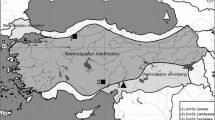Summary
Interphase nuclei isolated from paraffin-embedded tissue of four normal brains were hybridized with biotinated repetitive DNA probes specific for the (peri) centromeric regions of chromosomes 1 and 7. Hybridization results were visualized with a peroxidase-DAB system after which the number of specific signals per nucleus was counted using bright field microscopy. Using the probe specific for chromosome 7 (p7t1), both the cerebral and the cerebellar samples showed 2 spots in 82% and 83%, respectively, of the nuclei. In situ hybridization with the chromosome 1 probe (pUC1. 77) showed two spots in 69% of the cerebral nuclei. In cerebellar samples, hybridization with pUC1.77 resulted in only one large spot per nucleus in 82% of the cells. The average spot size in nuclei with one signal was about 1.6 times as large as that in nuclei with two signals. These observations suggest that the single large spot in the cerebellar cells is not the result of monosomy of chromosome 1 but that it reflects somatic pairing of the two chromosome 1 centromeres. Based on the size and the fraction of nuclei with one large spot, the small granular neuron is the most likely candidate. The difference between cerebral and cerebellar samples indicates that this somatic pairing of chromosome 1 is a cell-type-dependent phenomenon.
Similar content being viewed by others
References
Borden J, Manuelidis L (1988) Movement of the X chromosome in epilepsy. Science 242:1687–1691
Comings DE (1980) Arrangement of chromatin in the nucleus. Hum Genet 53:131–143
Cooke HJ, Hindley J (1979) Cloning of human satellite III DNA: different components are on different chromosomes. Nucleic Acids Res 6:3177–3197
Cremer T, Cremer C, Baumann H, Luedtke E-K, Sperling K, Teuber V, Zorn C (1982a) Rabl's model of the interphase chromosome arrangement tested in Chinese hamster cells by premature chromosome condensation and laser-UV-microbeam experiments. Hum Genet 60:46–56
Cremer T, Cremer C, Schneider T, Baumann H, Hens L, Kirsch-Volders M (1982b) Analysis of chromosome positions in the interphase nucleus of Chinese hamster cells by laser-UV-microirradiation experiments. Hum Genet 62:201–209
Cremer T, Tessin D, Hopman AHN, Manuelidis L (1988) Rapid interphase and metaphase assessment of specific chromosomal changes in neuroectodermal tumor cells by in situ hybridization with chemically modified DNA probes. Exp Cell Res 176:199–220
Devilee P, Thierry RF, Kievits T, Kolluri R, Hopman AHN, Willard HF, Pearson PL, Cornelisse CJ (1988) Detection of chromosome aneuploidy in interphase nuclei from human primary breast tumors using chromosome-specific DNA probes. Cancer Res 48:5825–5830
Driel-Kuller AMJ van, Mesker WE, Velzen I van, Tanke HJ, Feichtinger J, Ploem JS (1985) Preparation of monolayer smears from paraffin-embedded tissue for image cytometry. Cytometry 6:268–272
Hedley DW, Friedlander ML, Taylor IW, Rugg CA, Musgrove EA (1983) Method for analysis of cellular DNA content of paraffin-embedded pathological material using flow cytometry. J Histochem Cytochem 31:1333–1335
Hopman AHN, Wiegant J, Tesser GI, Duijn P van (1986) A nonradioactive in situ hybridization method based on mercurated nucleic acid probes and sulfhydryl-hapten ligands. Nucleic Acids Res 14:6471–6488
Hopman AHN, Ramaekers FCS, Raap AK, Beck JLM, Devilee P, Ploeg M van der, Vooijs GP (1988) In situ hybridization as a tool to study numerical chromosome aberrations in solid bladder tumors. Histochemistry 89:307–316
Hubert J, Bourgeois CA (1986) The nuclear skeleton and the spatial arrangement of chromosomes in the interphase nucleus of vertebrate somatic cells. Hum Genet 74:1–15
Landegent JE, Jansen in de Wal N, Baan RA, Hoeijmakers JHJ, Ploeg M van der (1984) 2-Acetylaminofluorene-modified probes for the indirect hybridocytochemical detection of specific nucleic acid sequences. Exp Cell Res 153:61–72
Langer PR, Waldrop AA, Ward DA (1981) Enzymatic synthesis of biotin labeled polynucleotides: novel nucleic acid affinity probes. Proc Natl Acad Sci USA 78:6633–6637
Maltby EL, Ironside JW, Battersby RD (1988) Cytogenetic studies in 50 meningiomas. Cancer Genet Cytogenet 31:199–210
Manuelidis L (1984) Different central nervous system cell types display distinct and nonrandom arrangements of satellite DNA sequences. Proc Natl Acad Sci USA 81:3123–3127
Manuelidis L, Borden J (1988) Reproducible compartmentalization of individual chromosome domains in human CNS cells revealed by in situ hybridization and three-dimensional reconstruction. Chromosoma 96:397–410
Nederlof PM, Robinson D, Abuknesha R, Wiegant J, Hopman AHN, Tanke HJ, Raap AK (1989a) Three-color fluorescence in situ hybridization for the simultaneous detection of multiple nucleic acid sequences. Cytometry 10:20–27
Nederlof PM, Flier S van der, Raap AK, Tanke HJ, Ploeg M van der, Kornips F, Geraedts JPM (1989b) In situ hybridization and cytogenetic studies of human tumors. Cancer Genet Cytogenet (in press)
Rabl C (1885) Über Zellteilung. Morphol Jahrb 10:214–330
Rappold GA, Cremer T, Hager KE, Muller CR, Yang T (1984) Sex chromosome positions in human interphase nuclei as studied by in situ hybridization with chromosome specific DNA probes. Hum Genet 67:317–325
Trask B, Engh G van den, Pinkel D, Mullikin J, Waldman F, Dekken H van Gray J (1988) Fluorescence in situ hybridization to interphase cell nuclei in suspension allows flow cytometric analysis of chromosome content and microscopic analysis of nuclear organization. Hum Genet 78:251–259
Vogel F, Schroeder TM (1974) The internal order of the interphase nucleus. Hum Genet 25:265–297
Waye JS, England SB, Willard HF (1987) Genomic organization of alpha satellite DNA on human chromosome 7: evidence for two distinct alphoid domains on a single chromosome. Mol Cell Biol 7:349–356
Willard HF, Waye JS (1987) Hierarchical order in chromosome-specific human alpha satellite DNA. Trends Genet 3:192–198
Author information
Authors and Affiliations
Rights and permissions
About this article
Cite this article
Arnoldus, E.P.J., Peters, A.C.B., Bots, G.T.A.M. et al. Somatic pairing of chromosome 1 centromeres in interphase nuclei of human cerebellum. Hum Genet 83, 231–234 (1989). https://doi.org/10.1007/BF00285162
Received:
Issue Date:
DOI: https://doi.org/10.1007/BF00285162




